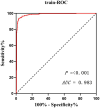Development and evaluation of a dynamic nomogram model for intraoperative blood transfusion decision-making
- PMID: 40584715
- PMCID: PMC12202218
- DOI: 10.3389/fmed.2025.1566325
Development and evaluation of a dynamic nomogram model for intraoperative blood transfusion decision-making
Abstract
Objective: By gathering data on patients with intraoperative blood transfusion and investigating the factors influencing intraoperative blood transfusion in patients, we aimed to construct a dynamic nomogram decision-making model capable of continuously predicting the probability of intraoperative blood transfusion in patients. This was done to explore a new mode of individualized and precise blood transfusion and to guide doctors to make timely and reasonable blood transfusion decisions and save blood resources.
Methods: Data of surgical patients in our hospital from 2019 to 2023 were collected. Among them, 705 patients who had blood transfusions were the experimental group, and 705 patients without intraoperative blood transfusions were randomly selected as the control group. Preoperative and intraoperative indicators of 1,410 patients were collected. 80% of the data set was used as the training set and 20% as the test set. In the training set, independent risk factors affecting intraoperative blood transfusion in patients were obtained through Lasso regression and binary logistic regression analysis, and the regression model was established and validated.
Results: Through Lasso regression with cross-validation and binary logistic regression analysis, the independent risk factors affecting patients' intraoperative blood transfusion decision-making were determined as ASAs (III) (OR = 3.009, 95% CI = 1.311-6.909), surgical grading (IV) (OR = 3.772, 95% CI = 1.112-12.789), EBL (OR = 1.003, 95% CI = 1.002-1.004), preHGB (OR = 0.932, 95% CI = 0.919-0.946), LVEF (OR = 1.063, 95% CI = 1.028-1.098), Temp (OR = 57.14, 95% CI = 9.740-35.204), preAPTT (OR = 1.147, 95% CI = 1.079-1.220), and preDD (OR = 1.127, 95% CI = 1.048-1.212). The area under the curve (AUC) of the receiver operating characteristic curve (ROC) of the training set was 0.983, p < 0.05. By calculating the Jordon index, when the Jordon index reached its maximum value, the corresponding diagnostic probability threshold was 0.515. When the model predicted that the probability threshold was 0.515, the sensitivity was 0.939 and the specificity was 0.964. These independent risk factors were introduced into R statistical software to fit the intraoperative blood transfusion decision-making dynamic nomogram model. The goodness of fit test of the model for the training set was χ 2 = 111.85, p < 0.01, and the AUCs of the training set and the testing set were 0.983 and 0.995, respectively, p < 0.05. The calibration curve showed that the predicted probability of the model was in good agreement with the observed probability. Clinical decision curves (CDA) and clinical impact curves were plotted to evaluate the clinical utility of the model and the net benefit of the model.
Conclusion: Variables were screened by Lasso regression, the model was developed by binary logistic regression, and a dynamic nomogram model for intraoperative transfusion decision-making was successfully fitted using R software. This model had good goodness of fit, discrimination, and calibration. The model can dynamically and instantaneously predict the probability of blood transfusion and its 95% confidence interval under the current patient indicators by selecting the patient's independent risk factors in the drop-down mode during the operation. It can assist doctors in making a reasonable blood transfusion decision quickly and save blood resources.
Keywords: Lasso regression; blood transfusion decision-making; nomogram modeling; peroperative; transfusion.
Copyright © 2025 Li, Jiang, Lin, Du, Shan and Qin.
Conflict of interest statement
The authors declare that the research was conducted in the absence of any commercial or financial relationships that could be construed as a potential conflict of interest.
Figures









Similar articles
-
Analysis of Risk Factors for Perioperative Transfusion in Hip Arthroplasty and Modeling of a Nomogram.Ann Ital Chir. 2025 Jul 10;96(7):956-966. doi: 10.62713/aic.4077. Ann Ital Chir. 2025. PMID: 40665942
-
Building a risk prediction model for anastomotic leakage postoperative low rectal cancer based on Lasso-Logistic regression.BMC Gastroenterol. 2025 Jul 30;25(1):540. doi: 10.1186/s12876-025-04128-y. BMC Gastroenterol. 2025. PMID: 40731389 Free PMC article.
-
A novel nomogram for predicting osteoporosis with low back pain among the patients in Wenshan Zhuang and Miao Autonomous Prefecture of China.Front Endocrinol (Lausanne). 2025 Jun 5;16:1535163. doi: 10.3389/fendo.2025.1535163. eCollection 2025. Front Endocrinol (Lausanne). 2025. PMID: 40538801 Free PMC article.
-
Intravenous magnesium sulphate and sotalol for prevention of atrial fibrillation after coronary artery bypass surgery: a systematic review and economic evaluation.Health Technol Assess. 2008 Jun;12(28):iii-iv, ix-95. doi: 10.3310/hta12280. Health Technol Assess. 2008. PMID: 18547499
-
Signs and symptoms to determine if a patient presenting in primary care or hospital outpatient settings has COVID-19.Cochrane Database Syst Rev. 2022 May 20;5(5):CD013665. doi: 10.1002/14651858.CD013665.pub3. Cochrane Database Syst Rev. 2022. PMID: 35593186 Free PMC article.
References
LinkOut - more resources
Full Text Sources

